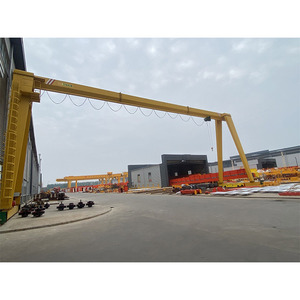
All categories
Featured selections
Trade Assurance
Buyer Central
Help Center
Get the app
Become a supplier

(743 products available)








































The gin pole derrick crane is a simple lifting device made of a vertical post (the gin pole) and a horizontal beam (the derrick cross piece). It can take different forms, depending on the design and parts of the crane.
Gin pole crane specifications vary depending on the type and application. Some critical specifications include the pole's material, weight capacity, height, and base type.
Regular maintenance ensures that gin pole cranes operate smoothly and safely. Here are some maintenance tips for a gin pole crane:
The versatility of the gin pole crane allows for its application in several industries and uses. Some of the uses of the gin crane include the following:
Construction Projects
The gin pole crane is popularly used for constructing buildings and other structures. The crane helps with moving heavy building materials like the timber, steel beams, and roofing components. The gin pole crane can swiftly lift those heavy items and place them accurately at the desired location. This ease of loading and offloading makes it a popular choice for construction sites.
Oil and Gas Industries
In this particular industry, the gin pole crane is used for maintenance projects and wellhead operations. The wellhead operation involves activities like installing or removing valves and pipes from the derrick. The maintenance projects may include tasks like equipment or pipe replacement. Gin pole cranes are preferred in oil and gas industries because they can be easily transported to remote areas and they are easy to set up.
Wind Farm Operations
Wind farms mainly use gin pole cranes during the maintenance of wind turbines. These turbines are on tall towers, so a gin pole crane helps to accurately lift the component of the turbine, like the rotor blades, to the needed height. With its simple design, the gin pole crane can erect new wind turbine towers.
Mining Operations
In the mining industry, the gin pole crane is used for several tasks like erecting structures, equipment maintenance, and lifting mining supplies. Equipment like the mineshaft towers are erected with the help of a gin pole crane. Also, heavy mining materials like the conveyor belts and drills are positioned with the assistance of this crane.
G Raising Heavy Loads
The gin pole crane can be operated by a single person when it's properly designed. Its simple design and ease of operation make it a perfect choice for lifting heavy loads in any area, especially tight spaces where bigger cranes cannot access.
Telecommunications Industry
The gin pole crane is used for installing communication towers and maintaining them. This includes tasks like installing antennas, securing the tower components, and making equipment transfers. The crane is preferred for these telecom tasks because it allows for precise lifts. Also, the operator can maneuver the crane easily to make the delicate lifts and placements.
Shifting Heavy Equipment
Heavy equipment like generators, transformers, and construction vehicles are shifted with the help of a gin pole crane. Its mobility makes it an ideal choice for shifting these heavy equipment to any location.
When choosing a gin pole derrick crane, a number of factors should influence the final decision. These include the construction material, maximum lifting capacity and height, stability, and safety features of the gin pole crane.
Construction material:
The material affects the strength, weight, and durability of the gin pole crane. A strong and durable material such as steel will ensure that the crane remains functional for a long period of time.
Maximum lifting capacity and height:
Determine the maximum weight and height that the gin pole crane can handle before choosing a specific model. Ensure that the lifting capacity and height of the crane surpasses the requirements of the intended applications.
Stability:
Choose a gin pole crane that is stable enough to safely handle heavy loads without tipping over. The stability of the crane can be affected by the base, outriggers, and the overall design.
Safety features:
Opt for a gin pole crane that has numerous safety features like overload protection, and safety locks among others. Outriggers provide a solid base for the gin pole crane, which improves stability and prevents it from toppling over during operation.
Q: What is the difference between a gin pole and a derrick?
A: While both the gin pole and derrick function as cranes for lifting loads, they differ in design and operation. The gin pole is simplistic and rotates to lift loads, relying mostly on ropes for its functionality. Derricks, on the other hand, have a more complex structure that involves a triangular shape achieved through the use of a diagonal beam and vertical posts. This crane derives stability and strength from the wood or metal used to construct it.
Q: What are some of the limitations of using a gin pole crane?
A: The gin pole crane has limited lifting capacity. This means that it's only capable of lifting loads of limited weight. Additionally, the height of the gin pole crane is limited. This makes it quite unsuitable for large-scale construction projects. Another limitation is the way the pole has to be positioned in order to lift a load. This makes it impractical in tight spaces.
Q: Are gin poles still widely used today?
A: Yes. Despite advancements in crane technology, gin poles are still widely used in various industries today. This is because they are cost-effective lifting solutions. Furthermore, their simplicity makes them easy to set up and operate.
Q: What safety measures should be considered when using a gin pole crane?
A: When using the gin pole crane, it's important to take some safety measures into consideration. This includes regularly inspecting the pole, ropes, and any other components for wear or damage. Ensure that all personnel are at a safe distance when the load is being lifted or lowered. Referring to the manufacturer's guidelines and ensuring proper training is also crucial if safety is to be maintained.